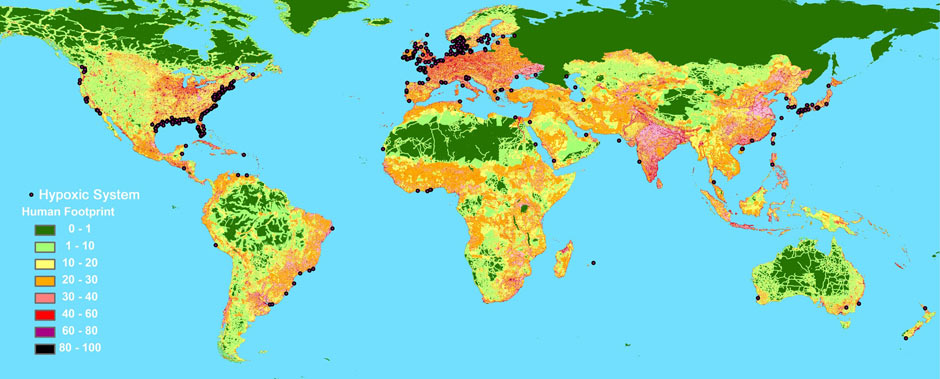 |
| A world map that contrasts wealth by nation with noted dead zones http://globalfoodpolitics.files.wordpress.com/2013/08/2008-08-15_bigmap.jpg |
Dead zones have increased in frequency since the 1970s when this
term was first used to describe hypoxic areas in water systems (What is Hypoxia 2013). In this time
period, there was an agricultural boom and farmers started using fertilizers that contained nitrogen and phosphorous for crop growth. These fertilizers were popular because they increased production. Because of this increased use of nitrogen and phosphorous, the nutrient
concentration has increased tremendously in the Lower Mississippi River which
connects to the Gulf (Marine Habitat Loss 2014). The dead zone in the Gulf of Mexico is the largest dead
zone affecting the United States and the second largest in the world. The
Gulf of Mexico is expansive and is only second to the dead zone in the Baltic
Sea in Europe (Adam 2008). The image above shows how the human footprints can contribute to hypoxic areas. The black dots represent hypoxic systems. Green countries don't leave a huge footprint while the orange, red, and purple countries have a large footprint.
 |
| A map of the Gulf of Mexico water shed. Pink represents cities, light green represents farmland, and blue represents rivers that feel into the Mississippi. http://gmoawareness.files.wordpress.com/2014/01/mississippi-hypoxic-zone-crop.jpg |
The Mississippi River is a basin that empties out into the
Gulf of Mexico through streams and waterways. (Wikipedia 2014). Many of the nutrients come
from runoff from small streams. This makes the control of pollution from these sources difficult
to handle (Algal Bloom 2014). The image to the right shows the path of the Mississippi River and waterways that lead to the Gulf of Mexico which is the yellow and blue part.
Works Cited:
What is Hypoxia?. (2013) Hypoxia In the Northern Gulf of Mexico. Gulf Hypoxia. (Date accessed: February 17, 2014.) http://www.gulfhypoxia.net/Research/Shelfwide%20Cruises/
Wikipedia. (2014) Dead Zone (Ecology). Wikipedia, the free encyclopedia. (Date accessed: February 16, 2014.) http://en.wikipedia.org/wiki/Dead_zone_(ecology)#Effects
Algal Bloom. (2014) Reference Article. Science Daily. (Date accessed: February 17, 2014.) http://www.sciencedaily.com/articles/a/algal_bloom.htm
Kenyon. (2014) Marine Habitat Loss in the Gulf of Mexico: An Agricultural Dilemma. Kenyon. (Date accessed: February 16, 2014.) http://www2.kenyon.edu/projects/Agri/ebus06.html
Adam, David. (August 14, 2008) Suffocating Dead Zones Spread Across World's Oceans. The Guardian. (Date accessed: February 16, 2014.)
http://www.theguardian.com/environment/2008/aug/14/pollution.endangeredhabitats